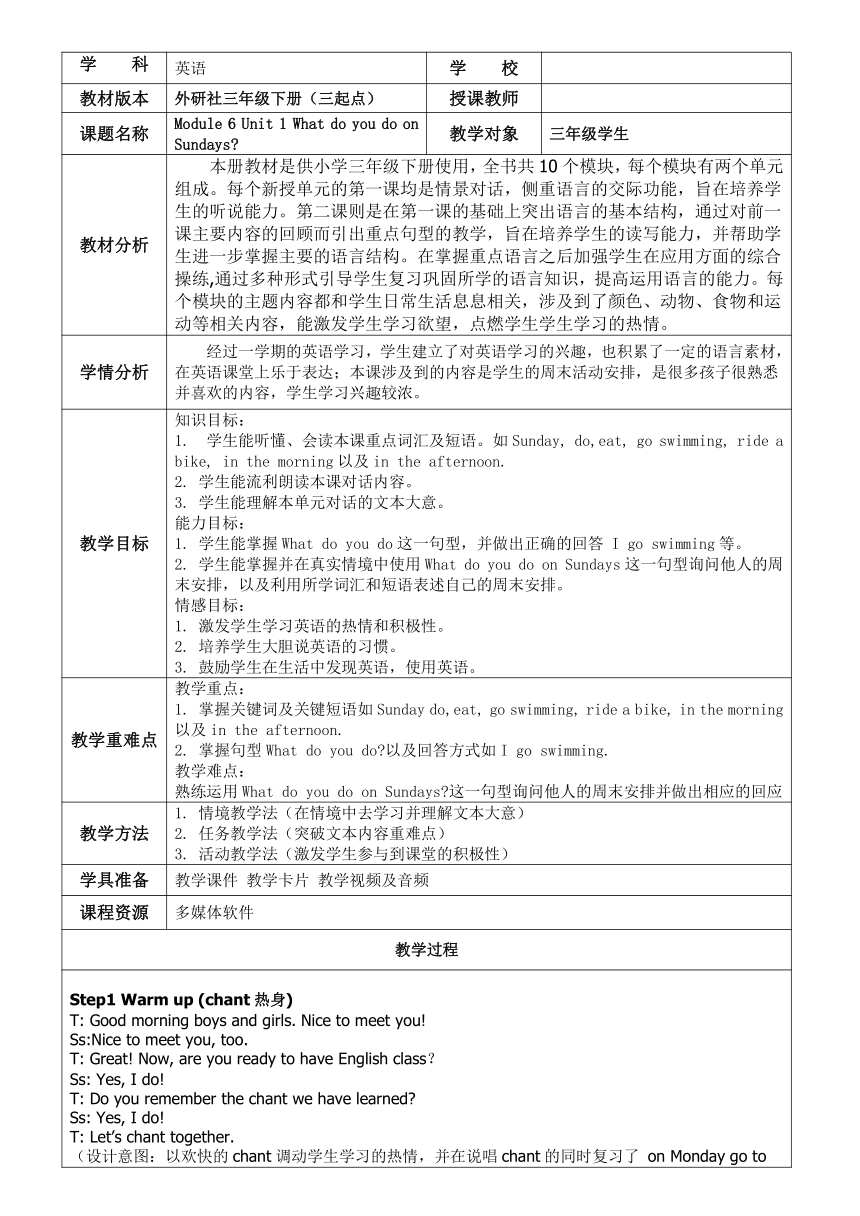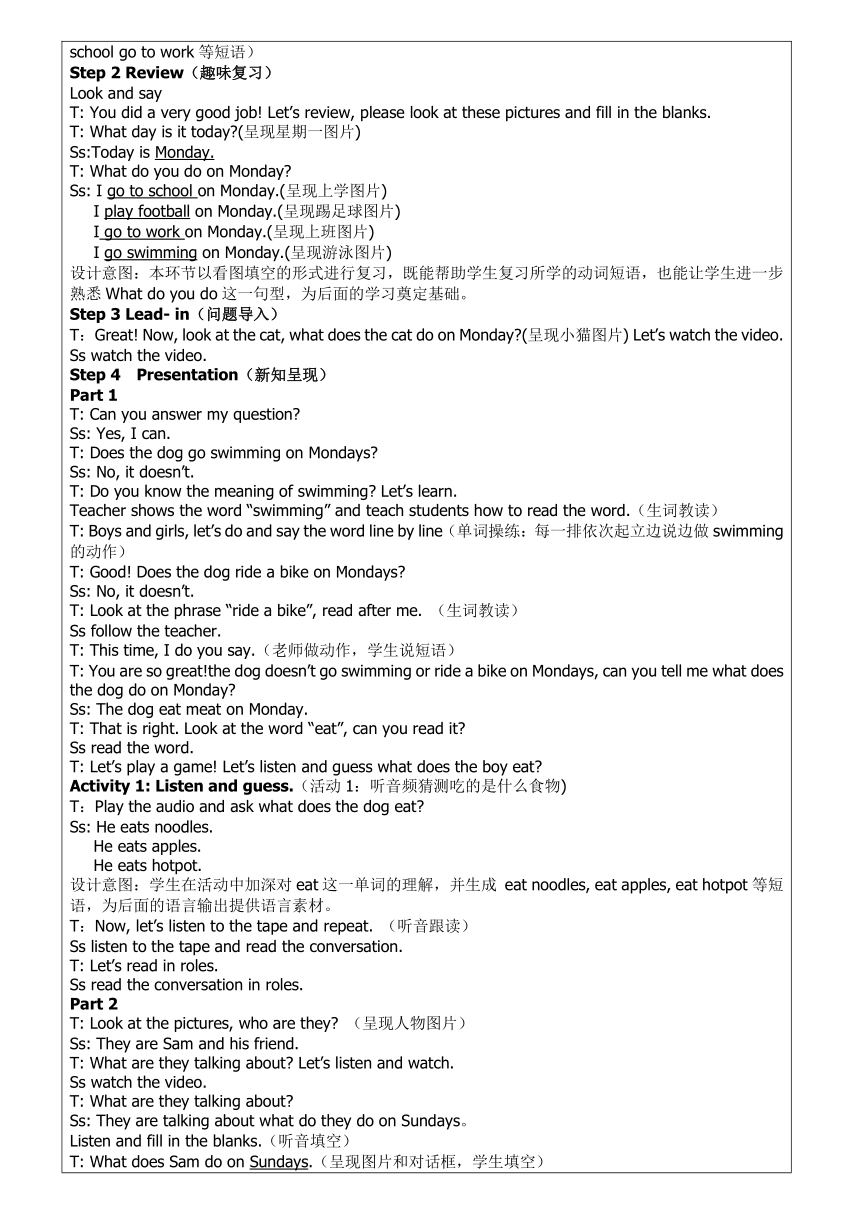Module 6 Unit 1 What do you do on Sundays?表格式教案
文档属性
| 名称 | Module 6 Unit 1 What do you do on Sundays?表格式教案 |  | |
| 格式 | docx | ||
| 文件大小 | 23.3KB | ||
| 资源类型 | 教案 | ||
| 版本资源 | 外研版(三年级起点) | ||
| 科目 | 英语 | ||
| 更新时间 | 2023-07-14 09:57:25 | ||
图片预览


文档简介
学 科 英语 学 校
教材版本 外研社三年级下册(三起点) 授课教师
课题名称 Module 6 Unit 1 What do you do on Sundays 教学对象 三年级学生
教材分析 本册教材是供小学三年级下册使用,全书共10个模块,每个模块有两个单元组成。每个新授单元的第一课均是情景对话,侧重语言的交际功能,旨在培养学生的听说能力。第二课则是在第一课的基础上突出语言的基本结构,通过对前一课主要内容的回顾而引出重点句型的教学,旨在培养学生的读写能力,并帮助学生进一步掌握主要的语言结构。在掌握重点语言之后加强学生在应用方面的综合操练,通过多种形式引导学生复习巩固所学的语言知识,提高运用语言的能力。每个模块的主题内容都和学生日常生活息息相关,涉及到了颜色、动物、食物和运动等相关内容,能激发学生学习欲望,点燃学生学生学习的热情。
学情分析 经过一学期的英语学习,学生建立了对英语学习的兴趣,也积累了一定的语言素材,在英语课堂上乐于表达;本课涉及到的内容是学生的周末活动安排,是很多孩子很熟悉并喜欢的内容,学生学习兴趣较浓。
教学目标 知识目标: 学生能听懂、会读本课重点词汇及短语。如Sunday, do,eat, go swimming, ride a bike, in the morning以及in the afternoon. 学生能流利朗读本课对话内容。 学生能理解本单元对话的文本大意。 能力目标: 学生能掌握What do you do这一句型,并做出正确的回答 I go swimming等。 学生能掌握并在真实情境中使用What do you do on Sundays这一句型询问他人的周末安排,以及利用所学词汇和短语表述自己的周末安排。 情感目标: 激发学生学习英语的热情和积极性。 培养学生大胆说英语的习惯。 鼓励学生在生活中发现英语,使用英语。
教学重难点 教学重点: 掌握关键词及关键短语如Sunday do,eat, go swimming, ride a bike, in the morning以及in the afternoon. 掌握句型What do you do 以及回答方式如I go swimming. 教学难点: 熟练运用What do you do on Sundays 这一句型询问他人的周末安排并做出相应的回应
教学方法 情境教学法(在情境中去学习并理解文本大意) 任务教学法(突破文本内容重难点) 活动教学法(激发学生参与到课堂的积极性)
学具准备 教学课件 教学卡片 教学视频及音频
课程资源 多媒体软件
教学过程
Step1 Warm up (chant热身) T: Good morning boys and girls. Nice to meet you! Ss:Nice to meet you, too. T: Great! Now, are you ready to have English class? Ss: Yes, I do! T: Do you remember the chant we have learned Ss: Yes, I do! T: Let’s chant together. (设计意图:以欢快的chant调动学生学习的热情,并在说唱chant的同时复习了 on Monday go to school go to work等短语) Step 2 Review(趣味复习) Look and say T: You did a very good job! Let’s review, please look at these pictures and fill in the blanks. T: What day is it today (呈现星期一图片) Ss:Today is Monday. T: What do you do on Monday Ss: I go to school on Monday.(呈现上学图片) I play football on Monday.(呈现踢足球图片) I go to work on Monday.(呈现上班图片) I go swimming on Monday.(呈现游泳图片) 设计意图:本环节以看图填空的形式进行复习,既能帮助学生复习所学的动词短语,也能让学生进一步熟悉What do you do这一句型,为后面的学习奠定基础。 Step 3 Lead- in(问题导入) T:Great! Now, look at the cat, what does the cat do on Monday (呈现小猫图片) Let’s watch the video. Ss watch the video. Step 4 Presentation(新知呈现) Part 1 T: Can you answer my question Ss: Yes, I can. T: Does the dog go swimming on Mondays Ss: No, it doesn’t. T: Do you know the meaning of swimming Let’s learn. Teacher shows the word “swimming” and teach students how to read the word.(生词教读) T: Boys and girls, let’s do and say the word line by line(单词操练:每一排依次起立边说边做swimming的动作) T: Good! Does the dog ride a bike on Mondays Ss: No, it doesn’t. T: Look at the phrase “ride a bike”, read after me. (生词教读) Ss follow the teacher. T: This time, I do you say.(老师做动作,学生说短语) T: You are so great!the dog doesn’t go swimming or ride a bike on Mondays, can you tell me what does the dog do on Monday Ss: The dog eat meat on Monday. T: That is right. Look at the word “eat”, can you read it Ss read the word. T: Let’s play a game! Let’s listen and guess what does the boy eat Activity 1: Listen and guess.(活动1:听音频猜测吃的是什么食物) T:Play the audio and ask what does the dog eat Ss: He eats noodles. He eats apples. He eats hotpot. 设计意图:学生在活动中加深对eat这一单词的理解,并生成 eat noodles, eat apples, eat hotpot等短语,为后面的语言输出提供语言素材。 T:Now, let’s listen to the tape and repeat. (听音跟读) Ss listen to the tape and read the conversation. T: Let’s read in roles. Ss read the conversation in roles. Part 2 T: Look at the pictures, who are they (呈现人物图片) Ss: They are Sam and his friend. T: What are they talking about Let’s listen and watch. Ss watch the video. T: What are they talking about Ss: They are talking about what do they do on Sundays。 Listen and fill in the blanks.(听音填空) T: What does Sam do on Sundays.(呈现图片和对话框,学生填空) T: Let’s read the word together. Ss read the word. T: Do you remember other words about the days in a week.(复习拓展周一到周日的单词) T: I go swimming. And I play football. (呈现图片和对话框,学生填空) T:Do you play football in the morning. No, I don’t. I play football in the afternoon.(呈现图片和对话框,学生填空) Teacher shows the pictures of morning and afternoon to explain the meaning of the phrases.(利用图片解释两个词组的意思) T:What do you do in the morning I sleep in the morning.(呈现图片和对话框,学生填空) T: Teacher shows the picture about sleeping and read the word group by group. (呈现睡觉的图片解释意思并以大组为单位进行单词的朗读操练) T: What do you do in the morning I ride my bike in the morning. What do you do in the afternoon I watch TV in the afternoon. (呈现图片和对话框,学生填空) T: You did a good job. Now let’s play a game. Activity 2: Fill in the blanks (活动2:小组合作完成表格) T:I am so proud of you! Now, let’s read the conversation and fill in the blanks(小组共读解决问题) Samin the morningin the afternoonSam’s friend
Ss work in teams and fill in the blanks.(完成表格,进一步加深学生对文本关键信息的理解) Step 5 Practice(练习巩固) T: You did a very good job! We know what do Sam and his friend do on Sunday, but do you know what do your classmates do on Sundays Now, you are the little reporters, go and interview your classmates. Activity 3: Little reporter(活动3:学生扮演小记者采访自己同学的周末活动) 设计意图:创设真实地情境让学生在真实的情境中使用What do you do on Sundays 和I go swimming等句型。人人都是小记者,人人都是被采访的人,都有机会使用本课所学句型。 Step 6 Summary(总结) T:What we have learned today Let’s review.(老师根据板书和学生一起回顾本堂课所学内容) Step 7 Homework(家庭作业) T: Here are three tasks for you. You can choose one to finish. Read the conversation. Write down your Sunday activities. Make a survey about your parents’ Sunday activities.
教材版本 外研社三年级下册(三起点) 授课教师
课题名称 Module 6 Unit 1 What do you do on Sundays 教学对象 三年级学生
教材分析 本册教材是供小学三年级下册使用,全书共10个模块,每个模块有两个单元组成。每个新授单元的第一课均是情景对话,侧重语言的交际功能,旨在培养学生的听说能力。第二课则是在第一课的基础上突出语言的基本结构,通过对前一课主要内容的回顾而引出重点句型的教学,旨在培养学生的读写能力,并帮助学生进一步掌握主要的语言结构。在掌握重点语言之后加强学生在应用方面的综合操练,通过多种形式引导学生复习巩固所学的语言知识,提高运用语言的能力。每个模块的主题内容都和学生日常生活息息相关,涉及到了颜色、动物、食物和运动等相关内容,能激发学生学习欲望,点燃学生学生学习的热情。
学情分析 经过一学期的英语学习,学生建立了对英语学习的兴趣,也积累了一定的语言素材,在英语课堂上乐于表达;本课涉及到的内容是学生的周末活动安排,是很多孩子很熟悉并喜欢的内容,学生学习兴趣较浓。
教学目标 知识目标: 学生能听懂、会读本课重点词汇及短语。如Sunday, do,eat, go swimming, ride a bike, in the morning以及in the afternoon. 学生能流利朗读本课对话内容。 学生能理解本单元对话的文本大意。 能力目标: 学生能掌握What do you do这一句型,并做出正确的回答 I go swimming等。 学生能掌握并在真实情境中使用What do you do on Sundays这一句型询问他人的周末安排,以及利用所学词汇和短语表述自己的周末安排。 情感目标: 激发学生学习英语的热情和积极性。 培养学生大胆说英语的习惯。 鼓励学生在生活中发现英语,使用英语。
教学重难点 教学重点: 掌握关键词及关键短语如Sunday do,eat, go swimming, ride a bike, in the morning以及in the afternoon. 掌握句型What do you do 以及回答方式如I go swimming. 教学难点: 熟练运用What do you do on Sundays 这一句型询问他人的周末安排并做出相应的回应
教学方法 情境教学法(在情境中去学习并理解文本大意) 任务教学法(突破文本内容重难点) 活动教学法(激发学生参与到课堂的积极性)
学具准备 教学课件 教学卡片 教学视频及音频
课程资源 多媒体软件
教学过程
Step1 Warm up (chant热身) T: Good morning boys and girls. Nice to meet you! Ss:Nice to meet you, too. T: Great! Now, are you ready to have English class? Ss: Yes, I do! T: Do you remember the chant we have learned Ss: Yes, I do! T: Let’s chant together. (设计意图:以欢快的chant调动学生学习的热情,并在说唱chant的同时复习了 on Monday go to school go to work等短语) Step 2 Review(趣味复习) Look and say T: You did a very good job! Let’s review, please look at these pictures and fill in the blanks. T: What day is it today (呈现星期一图片) Ss:Today is Monday. T: What do you do on Monday Ss: I go to school on Monday.(呈现上学图片) I play football on Monday.(呈现踢足球图片) I go to work on Monday.(呈现上班图片) I go swimming on Monday.(呈现游泳图片) 设计意图:本环节以看图填空的形式进行复习,既能帮助学生复习所学的动词短语,也能让学生进一步熟悉What do you do这一句型,为后面的学习奠定基础。 Step 3 Lead- in(问题导入) T:Great! Now, look at the cat, what does the cat do on Monday (呈现小猫图片) Let’s watch the video. Ss watch the video. Step 4 Presentation(新知呈现) Part 1 T: Can you answer my question Ss: Yes, I can. T: Does the dog go swimming on Mondays Ss: No, it doesn’t. T: Do you know the meaning of swimming Let’s learn. Teacher shows the word “swimming” and teach students how to read the word.(生词教读) T: Boys and girls, let’s do and say the word line by line(单词操练:每一排依次起立边说边做swimming的动作) T: Good! Does the dog ride a bike on Mondays Ss: No, it doesn’t. T: Look at the phrase “ride a bike”, read after me. (生词教读) Ss follow the teacher. T: This time, I do you say.(老师做动作,学生说短语) T: You are so great!the dog doesn’t go swimming or ride a bike on Mondays, can you tell me what does the dog do on Monday Ss: The dog eat meat on Monday. T: That is right. Look at the word “eat”, can you read it Ss read the word. T: Let’s play a game! Let’s listen and guess what does the boy eat Activity 1: Listen and guess.(活动1:听音频猜测吃的是什么食物) T:Play the audio and ask what does the dog eat Ss: He eats noodles. He eats apples. He eats hotpot. 设计意图:学生在活动中加深对eat这一单词的理解,并生成 eat noodles, eat apples, eat hotpot等短语,为后面的语言输出提供语言素材。 T:Now, let’s listen to the tape and repeat. (听音跟读) Ss listen to the tape and read the conversation. T: Let’s read in roles. Ss read the conversation in roles. Part 2 T: Look at the pictures, who are they (呈现人物图片) Ss: They are Sam and his friend. T: What are they talking about Let’s listen and watch. Ss watch the video. T: What are they talking about Ss: They are talking about what do they do on Sundays。 Listen and fill in the blanks.(听音填空) T: What does Sam do on Sundays.(呈现图片和对话框,学生填空) T: Let’s read the word together. Ss read the word. T: Do you remember other words about the days in a week.(复习拓展周一到周日的单词) T: I go swimming. And I play football. (呈现图片和对话框,学生填空) T:Do you play football in the morning. No, I don’t. I play football in the afternoon.(呈现图片和对话框,学生填空) Teacher shows the pictures of morning and afternoon to explain the meaning of the phrases.(利用图片解释两个词组的意思) T:What do you do in the morning I sleep in the morning.(呈现图片和对话框,学生填空) T: Teacher shows the picture about sleeping and read the word group by group. (呈现睡觉的图片解释意思并以大组为单位进行单词的朗读操练) T: What do you do in the morning I ride my bike in the morning. What do you do in the afternoon I watch TV in the afternoon. (呈现图片和对话框,学生填空) T: You did a good job. Now let’s play a game. Activity 2: Fill in the blanks (活动2:小组合作完成表格) T:I am so proud of you! Now, let’s read the conversation and fill in the blanks(小组共读解决问题) Samin the morningin the afternoonSam’s friend
Ss work in teams and fill in the blanks.(完成表格,进一步加深学生对文本关键信息的理解) Step 5 Practice(练习巩固) T: You did a very good job! We know what do Sam and his friend do on Sunday, but do you know what do your classmates do on Sundays Now, you are the little reporters, go and interview your classmates. Activity 3: Little reporter(活动3:学生扮演小记者采访自己同学的周末活动) 设计意图:创设真实地情境让学生在真实的情境中使用What do you do on Sundays 和I go swimming等句型。人人都是小记者,人人都是被采访的人,都有机会使用本课所学句型。 Step 6 Summary(总结) T:What we have learned today Let’s review.(老师根据板书和学生一起回顾本堂课所学内容) Step 7 Homework(家庭作业) T: Here are three tasks for you. You can choose one to finish. Read the conversation. Write down your Sunday activities. Make a survey about your parents’ Sunday activities.
同课章节目录
- Module 1
- Unit 1 It's the ABC song.
- Unit 2 My favourite colour is yellow.
- Module 2
- Unit 1 They are monkeys.
- Unit 2 The man is short.
- Module 3
- Unit 1 I like football.
- Unit 2 I don't like riding my bike.
- Module 4
- Unit 1 Do you like meat?
- Unit 2 Does Lingling like oranges?
- Module 5
- Unit 1 She goes to school on Mondays.
- Unit 2 Does your mum go to work on Saturdays?
- Module 6
- Unit 1 What do you do on Sundays?
- Unit 2 What does Lingling have at school?
- Module 7
- Unit 1 We fly kites in spring.
- Unit 2 It's warm today.
- Module 8
- Unit 1 It's on your desk.
- Unit 2 Daming flies a kite in the park.
- Module 9
- Unit 1 I've got a new book.
- Unit 2 Has Amy got a bike?
- Review Module
- Unit 1
- Unit 2
- Module 10
- Unit 1 Here's a red hat.
- Unit 2 She's got an orange sweater.
